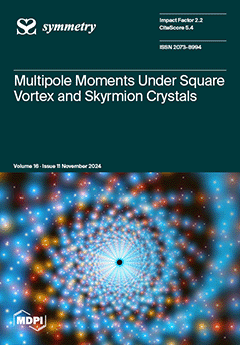The present paper reports the theoretical results on the thermal performance of proposed Integrated Hybrid Nanofluid Hemi-Spherical Fin Model assuming a combination of Fe
3O
4-Ni/C
6H
18OSi
2 hybrid nanofluid. The model leverages the concept of symmetrical
[...] Read more.
The present paper reports the theoretical results on the thermal performance of proposed Integrated Hybrid Nanofluid Hemi-Spherical Fin Model assuming a combination of Fe
3O
4-Ni/C
6H
18OSi
2 hybrid nanofluid. The model leverages the concept of symmetrical geometries and optimized nanoparticle shapes to enhance the heat flux, with a focus on symmetrical design applications in thermal engineering. The simulations are carried out by assuming a silicone oil as a base fluid, due to its exceptional stability in hot and humid conditions, enriched with superparamagnetic Fe
3O
4 and Ni nanoparticles to enhance the heat transfer capabilities, with the aim of contributing to the field of nanotechnology, electronics and thermal engineering, The focus of this work is to optimize the heat dissipation in systems that require high thermal efficiency and stability such as automotive cooling systems, aerospace components and power electronics. In addition, the study explores the influence of key parameters such as heat transfer coefficients and thermal conductivity that play an important role in improving the thermal performance of cooling systems. The overall thermal performance of the model is evaluated based on its heat flux and thermal efficiency. The study also examines the impact of the shape optimized nanoparticles in silicone oil by incorporating shape-factor in its modelling equations and proposes optimization of parameters to enhance the overall thermal performance of the system. Darcy’s flow model is used to analyse the key parameters in the system and study the thermal behaviour of the hybrid nanofluid within the fin by incorporating natural convection, temperature-dependent internal heat generation, and radiation effects. By using the similarity approach, the governing equations were reduced to non-linear ordinary differential equations and numerical solutions were obtained by using four-stage Lobatto-IIIA numerical technique due to its robust stability and convergence properties. This enables a systematic investigation of various influential parameters, including thermal conductivity, emissivity and heat transfer coefficients. Additionally, it stimulates interest among researchers in applying mathematical techniques to complex heat transfer systems, thereby contributing towards the development of highly efficient cooling system. Our findings indicate that there is a significant enhancement in the heat flux as well as improvement in the thermal efficiency due to the mixture of silicone oil and shape optimized nanoparticles, that was visualized through comprehensive graphical analysis. Quantitatively, the proposed model displays a maximum thermal efficiency of 57.5% for lamina shaped nanoparticles at
= 0.5,
= 0.2,
= 0.2 and
= 0.4. The maximum enhancement in the heat flux occurs when
doubles from 5 to 10 for
= 0.2 and
= 0.1. Optimal thermal performance is found for
,
and
values in the range 5 to 10, 0.2 to 0.4 and 0.4 to 0.8 respectively.
Full article





